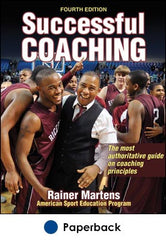When to teach whole versus part practice
This is an excerpt from Successful Coaching-4th Edition by Rainer Martens.
Whole Versus Part Practice
The whole method of practice is obvious: The whole technique is practiced intact. The part method is actually the whole-part-whole method. You teach the whole method as just outlined, practice it in parts, and then recombine the parts back into the whole via practice.
What's the best method to use? When possible, it's best to practice the whole technique; this avoids spending time combining the parts back into the whole and helps your athletes learn how to use the technique in the context of a contest. However, if the technique is so complex that athletes can't develop a good mental plan (the first stage of learning), then you should break the technique into parts.
When to Break Techniques Into Parts
To decide whether to break a technical skill into parts, you need to evaluate the task on two dimensions: its complexity and the interdependence of the parts. Two questions will help you determine task complexity, or how difficult it may be for athletes to develop a good mental plan:
- How many parts are there to the task?
- How mentally demanding is the task?
Next you need to evaluate how interdependent or independent the parts of the task are. That is, how closely is one part of the technique related to the next? For example, in the tennis serve, you can fairly easily separate the ball toss from the swing of the racket, but you really can't separate the racket swing and contact with the ball from the follow-through.
When the task is low in complexity and high in interdependence, have your athletes practice the whole technique. By contrast, part practice is better when the task is high in complexity and low in interdependence. I've illustrated this in figure 10.3, indicating how I would apply these rules for certain sport skills. You will notice that I've listed only one technique in the part method category. This is because few technical skills are low in interdependence. However, a great many technical skills can be taught by using a combination of the part and whole methods.
Where to Break Techniques Into Parts
Now you have some guidance as to when to break a technique into parts, but how do you know where to make the breaks in the sequence of movements? This is another judgment you must learn to make, perhaps with help from more experienced coaches. In general, the more interdependent the movement, the more it should be left intact. When you analyze a technique, look for points in the movement at which there is less interdependence, or where there is a transition from one type of movement to another. Most technical skills have a preparation phase, an action phase, and a follow-through phase. Often you can break between the preparation and action phases; it's usually not easy to break between the action and follow-through phases.
Integrating Parts Back Into the Whole
You can teach technical skills many different ways. Just because you are breaking a technique into parts, for example, doesn't mean that you must teach each part independently. If an athlete has mastered a few parts of a technique but still needs work on others, or if an athlete needs work on putting parts together, you might select the progressive-part method. Start by having an athlete practice the first part of a technique. Then move on to the next part by having the athlete practice it together with the first part. Continue by progressing through each part of the technique until the athlete is finally practicing the entire technique.
Attention focus is an approach that involves practicing the entire technique but concentrating on only one aspect of the technique. You might instruct discus throwers, for example, to practice the entire throw but to focus only on keeping the discus as far as possible from the body as they pull. This method tends to work best with higher-skilled athletes. Athletes who are still trying to learn the fundamentals of a technique may have difficulty focusing on only one aspect.


Get the latest insights with regular newsletters, plus periodic product information and special insider offers.
JOIN NOW
Latest Posts
- Outdoor recreation and adventure activities lead to positive health outcomes for children
- Schools offer a wide variety of adventure programs for children
- Using sport to change society
- Despite progress, equity remains a pressing challenge for women in sport
- What today’s athletes expect from coaches
- Barriers to youth participation in physical activity and sport


